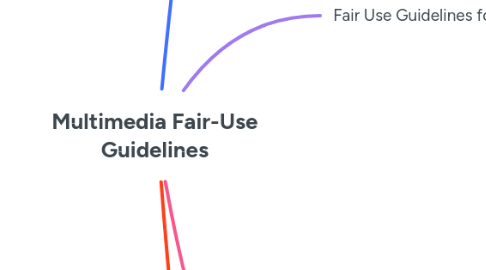
1. Copyrights & Intellectual Properties
1.1. Copyright
1.1.1. Definition
1.1.1.1. The law protects original works and gives creators exclusive rights to their works.
1.1.2. Scope of Application
1.1.2.1. Covering literature, music, drama, art, film, software and other types.
1.1.3. Content of rights
1.1.3.1. Including the right to reproduce, distribute, display and adapt.
1.2. Intellectual Properties
1.2.1. Trademark
1.2.1.1. Protect brand names, logos and slogans to prevent others from confusing consumers with similar logos.
1.2.2. Patent
1.2.2.1. Protects inventions and innovations, usually for a period of 20 years, giving the inventor exclusive rights.
1.2.3. Trade Secret
1.2.3.1. Protect undisclosed business information, such as recipes and customer lists, from competitors.
2. Fair Use Guidelines for Teachers
2.1. Educational Purposes
2.1.1. The primary purpose of the teacher's use of the material in the classroom is for teaching purposes, not for commercial purposes.
2.2. Amount Used
2.2.1. Not more than 10% of the work (such as book chapters or articles).
2.2.2. Single pictures, short video clips and other short materials.
2.3. Effect on Market
2.3.1. The work used must not negatively affect the marketing of the original work.
2.3.2. Teachers need to consider whether the material used will affect the income of the original author.
3. Tips on Avoiding Infringement of Copyright
3.1. Attribution
3.1.1. Always give proper credit to the original author, identifying the source and author of the work.
3.2. Use of Public Domain works
3.2.1. The use of works no longer protected by copyright is free for anyone to use.
3.3. Obtaining Permissions
3.3.1. Contact the copyright owner and obtain written permission before using copyrighted material.
3.3.2. Make it clear if you need to pay a user fee.
3.4. Creative Commons Licenses
3.4.1. Select works with creative Commons licenses and understand the license terms (attribution, non-commercial use, no adaptation, etc.).
4. Resources for Further Learning
4.1. Legal Resources
4.1.1. Visit the U.S. Copyright Office and other legal websites for the latest information on copyright law.
4.2. Workshops and Seminars
4.2.1. Attend seminars on copyright and fair use to deepen your understanding and application skills.
4.3. Online Tools
4.3.1. Use online tools to check the copyright status and terms of use of materials to ensure compliance.
